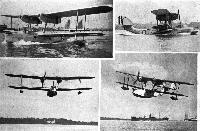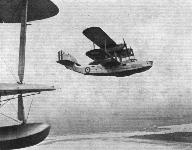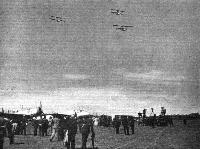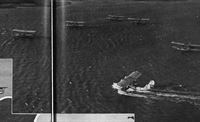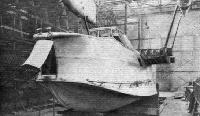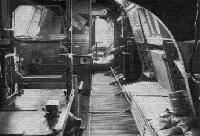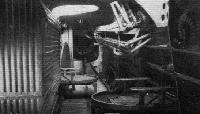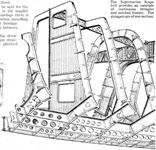
Варианты
- Supermarine - Swan - 1924 - Великобритания
- Supermarine - Southampton / Solent - 1925 - Великобритания
- Supermarine - Scapa - 1932 - Великобритания
- Supermarine - Stranraer - 1934 - Великобритания
Supermarine Scapa и Stranraer
Самолет Southampton зарекомендовал себя довольно надежным, это позволило разработать его новый вариант - Southampton Mk IV. Доработки, внесенные в конструкцию самолета, были столь значительны, что еще до завершения постройки прототипа ему дали новое обозначение - Scapa.
Хотя отличий от исходного Southampton было много, одним из наиболее заметных стала компоновка силовой установки из двух 525-сильных (391 кВт) ПД Rolls-Royce Kestrel IIIMS, установленных в гондолах прямо под верхним крылом. К числу других важных изменений можно отнести замену открытых тандемных кабин на одну закрытую, в которой пилоты сидели рядом, и использование двухкилевого оперения вместо трехкилевого. Еще одним существенным отличием, внешне незаметным, стал переход к цельнометаллическому силовому набору с полотняной обшивкой на всех несущих поверхностях.
Scapa имел экипаж из пяти человек, а размах его крыла составлял 22,86 м. Самолет развивал максимальную скорость 227 км/ч на высоте 1000 м. Вооружение включало три пулемета Lewis и 454 кг бомбовой нагрузки.
Британские ВВС получили четырнадцать серийных Scapa. Самолет недолго состоял на вооружении и был выведен из состава боевых частей уже в 1938 году.
<...>
- Supermarine Scapa и Stranraer
Фотографии
-
Aeroplane Monthly 1976-09 / C.Andrews - The Southampton saga
Регистрационный номер: S1648 [12] S1648 was originally known as the Southampton Mk IV, but was renamed Scapa in 1933. In fact, it differed in many ways from previous Southampton variants.
-
Aeroplane Monthly 1987-10 / A.Lumsden, T.Heffernan - Per Mare Probare (7)
Регистрационный номер: S1648 [12] This view of the prototype Scapa shows the clean, uncluttered installation of the two Kestrel engines, slung well forward on the upper wings with the radiators rather spoiling the attractive lines at the rear of the nacelles.
-
Flight 1933-10 / Flight
Регистрационный номер: S1648 [12] THE SUPERMARINE "SCAPA": This is the name given to the production model. The prototype was known as the Supermarine "Southampton IV." The engines are Rolls-Royce "Kestrels"
-
Aeroplane Monthly 1987-10 / A.Lumsden, T.Heffernan - Per Mare Probare (7)
Регистрационный номер: S1648 [12] The prototype Supermarine Scapa, S1648, was originally known as the Southampton Mk IV.
-
Flight 1936-02 / Flight
Регистрационный номер: S1648 [12] -
Aeroplane Monthly 1987-10 / A.Lumsden, T.Heffernan - Per Mare Probare (7)
Регистрационный номер: K4191 The first production Scapa, K4191, served with Nos 204 and 240 Squadrons following trials with the MAEE.
-
Flight 1934-04 / Flight
Регистрационный номер: S1648 [12] ASHORE: The "Scapa" on its launching trolley The machine is not an amphibian, and the trolley is, of course, left behind when the flying boat is afloat.
-
Aeroplane Monthly 1987-10 / A.Lumsden, T.Heffernan - Per Mare Probare (7)
Регистрационный номер: S1648 [12] View of the Scapa prototype, S1648. Defensive armament consisted of three 0.303in Lewis machine guns - one in the bow and two amidships.
-
Aeroplane Monthly 1987-10 / A.Lumsden, T.Heffernan - Per Mare Probare (7)
Регистрационный номер: S1648 [12] -
Flight 1935-11 / Flight
Регистрационный номер: K4200 [4] ACCEPTANCE TRIAL: One of the production-type Supermarine Scapa flying boats (two 525 h.p. Rolls-Royce Kestrel III engines) being launched for a test flight prior to delivery. The Scapa is the latest type of flying boat to go into service with the R.A.F.
-
Мировая Авиация 244
Регистрационный номер: K4200 [4] Scapa начали поступать на вооружение 202-й эскадрильи на Мальте в мае 1935 года; позднее этими самолетами оснастили 204-ю, 228-ю и 240-ю эскадрильи британских ВВС.
-
Air-Britain Aeromilitaria 1980-04
Регистрационный номер: K7306 Scapa K7306 was one of No.228 Squadron's boats
-
Flight 1940-04 / Flight
Регистрационный номер: K4200 [4] The Scapa had its Rolls-Royce Kestrels placed just under the upper wing. It is to be noted that the radiators were placed at the tail end of the nacelles.
-
Aeroplane Monthly 1987-10 / A.Lumsden, T.Heffernan - Per Mare Probare (7)
Регистрационный номер: K4200 [4] Scapa K4200, last of the first batch of ten delivered to the RAF in 1935, was bst following a collision with HMS Brazen while taking off from Alexandria in November the same year.
-
Flight 1934-04 / Flight
FROM ABOVE: The "Scapa" has a normal biplane wing structure, with struts and wires reduced to a minimum. The engines are Rolls-Royce "Kestrels."
-
Flight 1934-11 / Flight
Регистрационный номер: S1648 [12] Some Vickers-Supermarine machines: 1, The "Scapa" flying boat (two Rolls-Royce "Kestrels");
-
Aeroplane Monthly 1987-10 / A.Lumsden, T.Heffernan - Per Mare Probare (7)
Регистрационный номер: S1648 [12] Main recognition feature of the Scapa was the angular radiators at the rear of the engine nacelles. The flying-boat was powered by a pair of 525 h.p. Rolls-Royce Kestrels.
-
Flight 1935-05 / Flight
Регистрационный номер: S1648 [12] Supermarine "Scapas" are already in service in the Mediterranean. The engines are moderately supercharged "Kestrels" of 525 h.p.
-
Flight 1934-04 / Flight
Регистрационный номер: S1648 [12] "FORMATING": The Vickers Supermarine "Scapa" photographed from a "Southampton."
Другие самолёты на фотографии: Supermarine Southampton / Solent - Великобритания - 1925
-
Air-Britain Aeromilitaria 1980-02
Регистрационный номер: K4197 Kindly loaned by Charles W.Cain, the photograph shows a trio of Supermarine Scapas of No.204 Squadron over the crowded harbour at Alexandria. No.204 was deployed to Egypt during the Italian invasion of Ethiopia when the League of Nations was considering sanctions against Italy. Despite the 'crisis', none of the nine gun positions has a weapon mounted!
For the naval buff, HMS Barham is poking into the photo from the bottom, with two fleet minesweepers alongside. Two three-funnelled County-class heavy cruisers flank the furthermost Scapa and eight V-class destroyers are moored in pairs. -
Flight 1934-07 / Flight
FLYING BOATS: One of the most interesting events of the Display was the "fly past" of flying boats. Three of them are shown here - the Saunders-Roe R.24/31 (two Bristol "Pegasus") (left); the Short R.24/31 (two Rolls-Royce "Goshawk") (centre); and the Supermarine "Scapa" (two Rolls-Royce "Kestrel"), all of the open-sea reconnaissance multi-seater type. This photo was taken from another of the flying boats, the Blackburn "Perth" (three Rolls-Royce "Buzzard"), during rehearsals at Felixstowe.
Другие самолёты на фотографии: Blackburn Perth / R.B.3 - Великобритания - 1933Saunders-Roe London / A.27 - Великобритания - 1934Short Knuckleduster / S.18 - Великобритания - 1933
-
Flight 1936-06 / Flight
Three Vickers-Supermarine Flying Boats in Formation: In the lead is the Walrus, on the right is the Stranraer, and on the left the Scapa.
Другие самолёты на фотографии: Supermarine Stranraer - Великобритания - 1934Supermarine Walrus/Seagull V - Великобритания - 1933
-
Aeroplane Monthly 1985-06 / ??? - RAF Pageantry
The flying boats: In the vee, left to right, are the Vickers-Supermarine "Scapa" and "Stranraer," Short "Sarafand" and "Singapore III," and Saro "London"; bringing up the rear is the Saro "Cloud" (Short "Knuckleduster" ???)
Like fish out of water - six flying-boats from Felixstowe. They are, from left to right, Scapa, Stranraer, Sarafand, Singapore, London and, in the rear, the Cloud.Другие самолёты на фотографии: Saunders-Roe London / A.27 - Великобритания - 1934Short Knuckleduster / S.18 - Великобритания - 1933Short Sarafand / S.14 - Великобритания - 1932Short Singapore III / S.19 - Великобритания - 1934Supermarine Stranraer - Великобритания - 1934
-
Flight 1937-06 / Flight
Supermarine Scapa flying boats in the Firth of Forth.
-
Flight 1936-02 / Flight
MILITARY AND CIVIL: Singapores, Scapas and an Imperial Airways Calcutta off the Khedival Palace, Alexandria.
Другие самолёты на фотографии: Short Calcutta / Rangoon / S.8 - Великобритания - 1928Short Singapore III / S.19 - Великобритания - 1934
-
Flight 1938-02 / Flight
The moorings at Calshot. A Saro London of No. 201 Sqn. has just landed, while two more Londons and three Supermarine Scapas are moored out. The Scapas belong to the training squadron.
Другие самолёты на фотографии: Saunders-Roe London / A.27 - Великобритания - 1934
-
Aeroplane Monthly 1987-10 / A.Lumsden, T.Heffernan - Per Mare Probare (7)
Sequence of pictures showing how a spare Kestrel was manhandled to and from a boat with the aid of a block and tackle, a handful of chaps and the Scapa's own derrick.
-
Aeroplane Monthly 1987-10 / A.Lumsden, T.Heffernan - Per Mare Probare (7)
The prototype Scapa with an 18in torpedo mounted on a cradle amidships for transit purposes - a spare engine could be similarly carried.
-
Aeroplane Monthly 1987-10 / A.Lumsden, T.Heffernan - Per Mare Probare (7)
Close-up of the Scapa’s beautifully cowled Rolls-Royce Kestrel IIIMS engine.
-
Flight 1936-02 / Flight
A view of the hull, with wing roots in place.
-
Flight 1936-02 / Flight
A Scapa engine nacelle. In this view the nacelle has been placed on its side in order to show the inspection doors in the floor by which engineers reach the engines. The nacelle is of all-metal construction.
-
Flight 1936-02 / Flight
The photograph forms an interesting companion to the sketch on the previous page in that it shows the special ribs in the wing root. These ribs are of channel section.
-
Flight 1936-02 / Flight
Interior of the Scapa looking towards the bows
-
Flight 1936-02 / Flight
Interior of the Scapa. The camera was pointing towards stem of the hull.
-
Flight 1933-07 / Flight Advertisements
Vickers Supermarine "Scapa" Rolls-Royce Kestrel engines.
-
Flight 1935-06 / Flight
Among the seven flying boats which are to appear at the R.A.F. Display on Saturday is the Vickers-Supermarine "Scapa," which is now being used in considerable numbers; its duties include reconnaissance, bombing, and navigational training. The engines are two Rolls-Royce "Kestrel III M.S." (525 h.p. moderately supercharged vee-twelve water-cooled); the span is 75 ft. and overall length 53 ft. This part-sectional drawing by G. H. Davis shows the layout of the crew accommodation and principal features.
-
Flight 1936-02 / Flight
The Vickers-Supermarine Scapa all-metal hull. The large drawing shows the shape and arrangement of the frames, bottom stringers, etc., while the smaller sketches illustrate various typical joints whose location in the hull is indicated by the reference letters. On the right is an enlarged view of a portion of the bow frame and its attachment to the keel.
-
Flight 1938-12 / Flight
The Supermarine Scapa hull provides an example of continuous stringers and notched frames. The stringers are of vee-section.
-
Flight 1936-02 / Flight
A somewhat unusual wing spar construction is used in the Supermarine Scapa biplane flying boat. The spar, known as a “Sigma” section, is built up of three corrugated strips
- Фотографии


